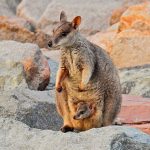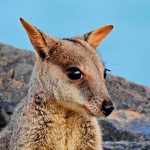ALLIED ROCK WALLABY
The Allied Rock-wallaby is a small to medium-sized marsupial, standing about 50 to 60 centimetres tall, with a tail that can extend up to 70 centimetres. Its fur is a soft, grey-brown, blending seamlessly with the rocky terrain. A distinctive feature is the lighter stripe running from its nose to between its eyes, giving it a uniquely expressive face. Their hind legs are strong and muscular, perfectly adapted for bounding across the uneven surfaces of their habitat.
These wallabies are primarily found in Queensland, particularly in the coastal ranges and inland rocky areas. Their preferred habitats are steep, rocky slopes and cliffs, where they find shelter and safety from predators. The rugged terrain is not just a home but a playground for these nimble creatures. They can leap several metres across rocky gaps and scale steep cliffs with ease, making them one of the most agile members of the macropod family.
Allied Rock-wallabies are herbivores, with a diet comprising grasses, leaves, and fruits. They have a keen ability to find food in their rocky environment, often feeding during the cooler hours of the day or at night to avoid the harsh midday sun.
When it comes to breeding, these wallabies have a fascinating reproductive strategy. They can breed throughout the year, but most births occur during the wet season when food is abundant. After a gestation period of about 30 days, the tiny joey is born and makes its way to the mother’s pouch, where it continues to develop for several months. Once it emerges, the joey will still rely on its mother for nourishment and protection until it is fully independent.
While generally quiet, the Allied Rock-wallaby does communicate through a series of soft clicks and grunts, especially during social interactions or when warning others of potential danger. These vocalisations are subtle but play a crucial role in their social structure.
In terms of longevity, these wallabies can live up to 10 to 15 years in the wild, provided they evade predators and disease. Their survival is a testament to their adaptability and the protective nature of their rocky homes.
The Allied Rock-wallaby is listed as “Near Threatened” on the IUCN Red List. Habitat destruction, fragmentation and predation by introduced cats and dogs, competition from introduced species like feral goats pose significant threats to their populations.
In the grand tapestry of Australia’s wildlife, the Allied Rock-wallaby is a symbol of resilience and adaptation. As we learn more about these fascinating creatures, we are reminded of the delicate balance of nature and the importance of preserving the unique habitats that support such extraordinary life.













